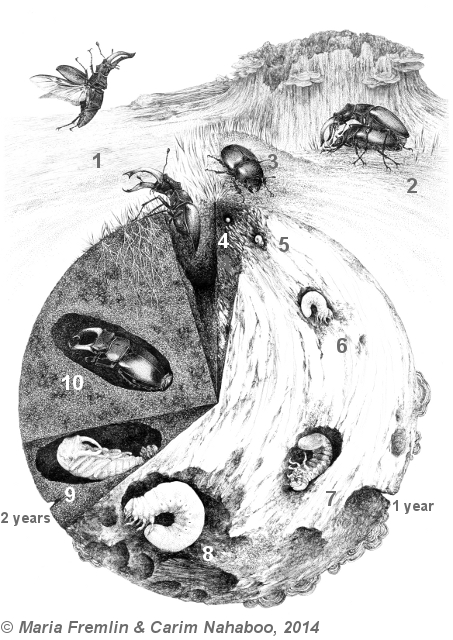
Adult
stag beetles (Lucanus cervus L.) live out in the open for a few weeks but prior to that they lead a mysterious long life underground.To view this diagram just move the mouse pointer over the numbers. This way you can see the corresponding text appear in the box on the right hand-side of the life cycle.

|
Stag beetles - All they need is love and wood
This life cycle was designed by Maria Fremlin, based on her research*, and illustrated by Carim Nahaboo.
* The current life cycle duration of “at least 3 years” is based on Maria Fremlin's research carried out in Colchester, North-east Essex, UK, listed below; but it could be one year longer longer if, for instance, there has been a colder winter/spring, which will delay the larval development. However, in the Continent, the minimum life cycle duration is 4 years, this probably because the beetles are bigger than the ones in the UK, thus take longer to develop, and/or other climatic factors.
Higher resolution digital files are available on request, but they incur a charge. Also, a limited edition of A3 prints is on sale. If interested, please, contact Carim Nahaboo.
1. Rearing trial in a terrarium in a well ventilated garage; eggs laid in July-August 2009, teneral imagos in September 2011 (unpublished).
2. Stump cut in early 2009, female stag bbetle observed going into a crack in late June 2009 [PDF]; followed by the emergence of two males in 21 May 2012 [PDF].
3. Pile of freshly cut wood chips made in 28 June 2010, teneral imagos in October 2012 [PDF].
4. Apple stump buried with lots of wood chips next to an existing nest, in March 2010; emergence holes June 2013 [PDF].
5. Large horse chestnut tree felled on October 2011, a couple of emergence holes in early June 2014. This stump soon developed fruiting bodies of turkey tail Trametes versicolor, which is strongly associated with the presence of stag beetles; for more see Model stag beetle nest.
Last modified: Jan 31 2023
| Main | Illustrated life cycle | Life cycle drawing | Body Map | Quiz |